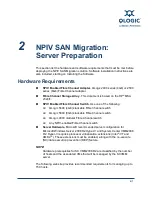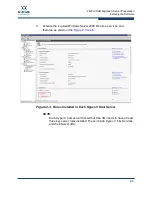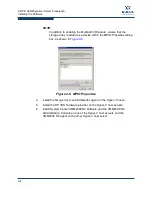
1-Introduction
Microsoft Windows Server 2008 R2 Hyper-V
1-2
The deployment scenario in this document demonstrates NPIV VM migration in a
SAN-attached Hyper-V host environment. In addition, the document also
discusses the pass-through storage option in Hyper-V and the benefits delivered
when deployed in conjunction with an NPIV-enabled Fibre Channel adapter.
Finally, this guide explores QLogic‘s PRO management pack for Microsoft
System Center Virtual Machine Manager 2008 R2. This software pack enables
optimum utilization of Fibre Channel storage I/O resources when multiple
virtualized Hyper-V workloads share a common adapter port.
Microsoft Windows Server 2008 R2 Hyper-V
Beginning with Windows Server 2008, server virtualization using Hyper-V
technology has been an integral part of the operating system. Microsoft Windows
Server 2008 R2 Hyper-V is the next-generation, hypervisor-based server
virtualization technology. It maximizes server hardware investments by
consolidating multiple server roles as separate virtual machines (VMs) running
on a single physical machine. Hyper-V efficiently runs multiple, different
operating systems
—Windows, Linux
®
, and others
—in parallel, on a single server,
while fully leveraging the power of x64 computing.
Hyper-V provides a dynamic, reliable, and scalable virtualization platform
combined with a single set of integrated management tools to manage both
physical and virtual resources, enabling the seamless creation of an agile and
dynamic data center. Hyper-V features include:
Server Consolidation
, the ability to consolidate many servers in a single
system while maintaining isolation. Server consolidation lowers total cost of
ownership (TCO), not just by lowering hardware requirements, but also by
reducing power, cooling, and management costs.
Business Continuity and Disaster Recovery
, the ability to minimize both
scheduled and unscheduled downtime. Hyper-V features live backup; quick
migration; and with Windows Server 2008 R2, live migration; all of which
enable businesses to meet stringent uptime and response metrics.
Testing and Development
, one of the first business functions to take
advantage of virtualization technology. Using virtual machines,
development staffs can create and test a wide variety of scenarios in a
safe, self-contained environment that accurately approximates the
operation of physical servers and clients.
Dynamic Data Center
, an integral part of a dynamic IT environment, uses
virtualization not only to respond to problems, but also to anticipate
increased demands. Hyper-V, together with enhanced versions of existing
system management solutions such as Microsoft System Center Virtual
Summary of Contents for Fibre Channel NPIV Storage Networking Guide
Page 10: ...I Deployment Best Practices for NPIV SAN Migration I 2 Notes...
Page 18: ...1 Introduction NPIV VMM2008 R2 SAN Migration Steps 1 8 Notes...
Page 54: ...II Resolving Fibre Channel Adapter Saturation on Hyper V Workloads II 2 Notes...
Page 60: ......
Page 62: ...III Using the Hyper V Pass through Disk Option III 2...
Page 77: ......













































